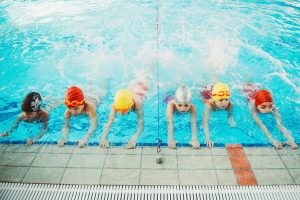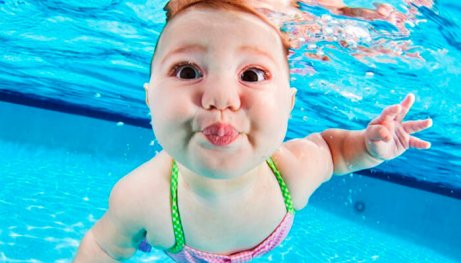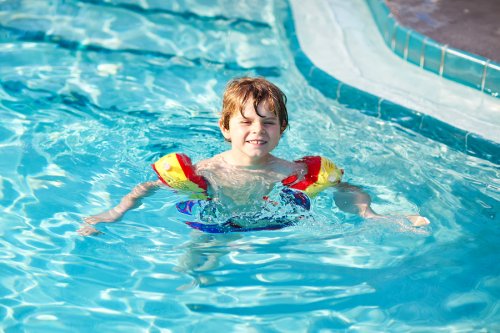Why Is It So Important for Children to Learn to Swim?

Swimming is a very complete physical activity. It requires that children exercise their bodies and minds while they have fun. One of the great wonders of swimming is that babies can start to swim when they’re as young as 6 months old.
Little ones learn to feel comfortable in the water, blow bubbles, and hold their breath. Any complete swimming program will also include teaching children to float on their backs and tread water.
Learning to swim has tremendously rewarding. Among other benefits, it can literally save a child from a dangerous situation. Children are constantly exposed to danger: rivers, lakes, docks, boat outings, pools… Furthermore, the sooner your children to swim, the more it contributes to their overall mental and physical health.
10 reasons your children should learn to swim
1. Knowing how to swim is essential to a child’s safety
Drowning is the second cause of unintentional death related to injury in children ages 0 to 14. It’s vital that children learn how to swim from an early age. Parents need to make sure that their children are comfortable and safe when they’re in or around water.
2. Swimming is a low-impact sport
Given that swimming takes place in water, 90 percent of the body is floating. Therefore, gravity doesn’t cause the body to hit the ground. Swimming offers resistance training. It’s an ideal activity for toning one’s shoulders, arms, back and abdomen.

3. Swimming is one of the most complete sports
It contributes to a child’s physical, emotional and neurological development. At the same time, it reduces the risk of suffering cardiovascular disease and improves metabolism. It also increases lung capacity – increasing a child’s resistance to childhood asthma.
4. It’s a very budget-friendly activity
Many cities offer public pools and lakes that families can access for free, or at a very low cost. Some schools include swimming as part of their educational program, and many universities offer swimming scholarships.
5. Swimming is a social activity
Swimming allows children to interact with their peers. It’s an excellent opportunity for little ones to learn social skills and establish friendships.
6. Children learn the value of teamwork, self-motivation and going after their goals
Swimming offers challenges, achievements and rewards. All of this helps our children to have confidence in themselves and believe in their abilities, building self-esteem.
“Swimming is a very complete physical activity. It requires that children exercise their bodies and minds while having fun.”
7. Learning to swim is a skill that children will use for the rest of their lives
Giving children the possibility of learning how to swim is an enormous gift that will accompany them for the rest of their lives. Swimming contributes to your child’s lifelong physical and mental health.
8. The act of swimming causes our bodies to release endorphins
As a result, the chances of suffering from depression decrease and mood instantly improves.
9. Swimming is highly recommended for children with disabilities
Children with autism, for example, tend to love the water. This environment provides them with a state of calm that makes them feel better.
10. Learning to swim provides a foundation for other sports
The ability to swim opens the door to other aquatic sports. Some of these include sailing, scuba diving, canoeing, kayaking, surfing, triathlons, water polo, etc.
Parents play a fundamental role in teaching their children to swim. Their presence provides their children with a greater sense of safety and stability, strengthening family bonds.

Tips for parents
Below is a list of suggestions to keep in mind when it comes to teaching your children to swim:
- You should teach your children to swim as soon as possible. It’s best for children to learn how to swim before they reach age 6.
- In order for children to warm up to the idea of swimming, it’s important for them to see other children swimming and having fun. This will help them associate swimming with having a good time.
- Parents should get into the water and accompany their children as long as they want.
- The best thing you can do is to teach through play and grab your child’s attention.
- It’s important not to pressure your children. Stay as relaxed as possible so that your little ones can relax as well.
- A relaxed environment will help your children enjoy the activity, motivating them to learn to swim. Do your best to make this a positive experience that your child will want to repeat.
These basic but effective notions will make the task of teaching your children to swim much simpler. As you’ve seen, the benefits of swimming are numerous and last a lifetime.
All cited sources were thoroughly reviewed by our team to ensure their quality, reliability, currency, and validity. The bibliography of this article was considered reliable and of academic or scientific accuracy.
- Newman, V. H. (2002). Teaching an infant to swim. iUniverse.
- Moran, K., & Stanley, T. (2006). Toddler drowning prevention: teaching parents about water safety in conjunction with their child’s in-water lessons. International journal of injury control and safety promotion, 13(4), 254-256. https://www.tandfonline.com/doi/abs/10.1080/17457300600678201
- Pečaver, A., Pungeršek, M., Videmšek, M., Karpljuk, D., Štihec, J., & Meško, M. (2014). Analysis of didactic approaches to teaching young children to swim. The Sport Journal, 17. https://www.cabdirect.org/?target=%2fcabdirect%2fabstract%2f20153072442
- Willard, N. (2010). Teach them to swim. Knowledge Quest, 39(1), 54. https://search.proquest.com/openview/acaf5e320275bf37dfc4dda7d0057bf8/1?pq-origsite=gscholar&cbl=6154
This text is provided for informational purposes only and does not replace consultation with a professional. If in doubt, consult your specialist.



